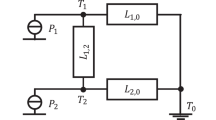Abstract
Customer demands for a cost-effective and demand-oriented determination of the oil change time for gears have led to the development of a new method for determining condition-based oil change times. A software implemented in the frequency inverter, which continuously calculates the gear oil temperature, is a core component of the method. The frequency inverter calculates the optimum oil change time continuously on the basis of the oil temperature as an essential influencing factor on oil ageing and taking into account further oil-specific parameters as well as empirical values. The manuscript describes the calculation method on which the algorithm is based and presents the results of the extensive validation of the developed oil temperature calculation.
Zusammenfassung
Kundenforderungen nach einer kostengünstigen und bedarfsgerechten Bestimmung des Ölwechselzeitpunkts bei Getrieben haben zu einer Entwicklung einer neuen Methode zur Bestimmung zustandsbasierter Ölwechselzeitpunkte geführt. Eine im Frequenzumrichter implementierte Software, die kontinuierliche die Getriebeöltemperatur berechnet, ist Kernbestandteil der Methode. Der Frequenzumrichter berechnet auf Basis der Öltemperatur als wesentlichen Einflussfaktor auf die Ölalterung und unter Berücksichtigung weiterer ölspezifischer Parameter sowie Erfahrungswerte kontinuierlich den optimalen Ölwechselzeitpunkt. Das Manuskript beschreibt die dem Algorithmus zugrundeliegende Berechnungsmethode und stellt Ergebnisse der umfangreichen Validierung der entwickelten Öltemperaturberechnung vor.








Similar content being viewed by others
References
Klüber Lubrication München SE & CO. KG (2015) Brochure “Geared up for success”. Klüber Lubrication, München
Krieger H (2003) Alterung von Schmierstoffen im Zahnradprüfstand und in Praxisgetrieben, Dissertation. TU München, München
ISO/TR 14179-2 (2001) Gears — Thermal capacity, Thermal load-carrying capacity
Winter H, Funck G (1987) Wärmehaushalt bei Getrieben – erläutert am Beispiel eines Kegel-Stirnradgetriebes. Tribologie + Schmierstofftechnik 34:4
Linke H (1996) Stirnradverzahnung. Carl Hanser, München
Bendzulla J, Bouché B, Thiele R (2015) New analysis on the heat balance of industrial gearboxes – optimized calculation-method of a gearbox manufacturer, VDI-Berichte 2255.2. International Conference on Gears, München. VDI Verlag, Düsseldorf
Author information
Authors and Affiliations
Corresponding author
Rights and permissions
About this article
Cite this article
Lotz, J., Bouché, B. & Thiele, R. Sensorless evaluation of the ideal timing for oil-change. Forsch Ingenieurwes 83, 379–385 (2019). https://doi.org/10.1007/s10010-019-00364-3
Received:
Accepted:
Published:
Issue Date:
DOI: https://doi.org/10.1007/s10010-019-00364-3




